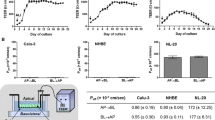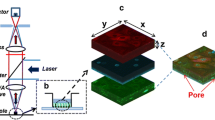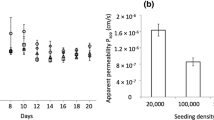ABSTRACT
Purpose
We sought to identify key variables in cellular architecture and physiology that might explain observed differences in the passive transport properties of small molecule drugs across different airway epithelial cell types.
Methods
Propranolol (PR) was selected as a weakly basic, model compound to compare the transport properties of primary (NHBE) vs. tumor-derived (Calu-3) cells. Differentiated on Transwell™ inserts, the architecture of pure vs. mixed cell co-cultures was studied with confocal microscopy followed by quantitative morphometric analysis. Cellular pharmacokinetic modeling was used to identify parameters that differentially affect PR uptake and transport across these two cell types.
Results
Pure Calu-3 and NHBE cells possessed different structural and functional properties. Nevertheless, mixed Calu-3 and NHBE cell co-cultures differentiated as stable cell monolayers. After measuring the total mass of PR, the fractional areas covered by Calu-3 and NHBE cells allowed deconvoluting the transport properties of each cell type. Based on the apparent thickness of the unstirred, cell surface aqueous layer, local differences in the extracellular microenvironment explained the measured variations in passive PR uptake and permeation between Calu-3 and NHBE cells.
Conclusion
Mixed cell co-cultures can be used to compare the local effects of the extracellular microenvironment on drug uptake and transport across two epithelial cell types.






Similar content being viewed by others
Abbreviations
- 4-OHP:
-
4-hydroxypropranolol
- DMEM:
-
Dulbecco’s Modified Eagle Medium
- FBS:
-
Fetal bovine serum
- LC/MS:
-
Liquid chromatography-mass spectrometry
- LY:
-
Lucifer yellow
- N-DIP:
-
N-desisopropyl propranolol
- PR:
-
Propranolol
REFERENCES
Yamashita S, Furubayashi T, Kataoka M, Sakane T, Sezaki H, Tokuda H. Optimized conditions for prediction of intestinal drug permeability using Caco-2 cells. Eur J Pharm Sci. 2000;10(3):195–204.
Irvine JD, Takahashi L, Lockhart K, Cheong J, Tolan JW, Selick HE, et al. MDCK (Madin-Darby canine kidney) cells: a tool for membrane permeability screening. J Pharm Sci. 1999;88(1):28–33.
Fogh J, Fogh JM, Orfeo T. One hundred and twenty-seven cultured human tumor cell lines producing tumors in nude mice. J Natl Cancer Inst. 1977;59(1):221–6.
Mathias NR, Timoszyk J, Stetsko PI, Megill JR, Smith RL, Wall DA. Permeability characteristics of Calu-3 human bronchial epithelial cells: in vitro-in vivo correlation to predict lung absorption in rats. J Drug Target. 2002;10(1):31–40.
Gruenert DC, Finkbeiner WE, Widdicombe JH. Culture and transformation of human airway epithelial cells. Am J Physiol. 1995;268(3):L347–60.
Forbes II. Human airway epithelial cell lines for in vitro drug transport and metabolism studies. Pharm Sci Technolo Today. 2000;3(1):18–27.
Wan H, Winton HL, Soeller C, Stewart GA, Thompson PJ, Gruenert DC, et al. Tight junction properties of the immortalized human bronchial epithelial cell lines Calu-3 and 16HBE14o-. Eur Respir J. 2000;15(6):1058–68.
Grainger CI, Greenwell LL, Lockley DJ, Martin GP, Forbes B. Culture of Calu-3 cells at the air interface provides a representative model of the airway epithelial barrier. Pharm Res. 2006;23(7):1482–90.
Grainger CI, Saunders M, Buttini F, Telford R, Merolla LL, Martin GP, et al. Critical characteristics for corticosteroid solution metered dose inhaler bioequivalence. Mol Pharm. 2012;9(3):563–9.
Patton JS, Brain JD, Davies LA, Fiegel J, Gumbleton M, Kim KJ, et al. The particle has landed-characterizing the fate of inhaled pharmaceuticals. J Aerosol Med Pulm Drug Deliv. 2010;23(S2):S71–87.
Suresh MV, Wagner MC, Rosania GR, Stringer KA, Min KA, Risler L, et al. Pulmonary administration of a water-soluble curcumin complex reduces severity of acute lung injury. Am J Respir Cell Mol Biol. 2012;47(3):280–7.
Florea BI, Cassara ML, Junginger HE, Borchard G. Drug transport and metabolism characteristics of the human airway epithelial cell line Calu-3. J Control Release. 2003;87(1–3):131–8.
Foster KA, Avery ML, Yazdanian M, Audus KL. Characterization of the Calu-3 cell line as a tool to screen pulmonary drug delivery. Int J Pharm. 2000;208(1–2):1–11.
Tronde A, Norden B, Marchner H, Wendel AK, Lennernas H, Bengtsson UH. Pulmonary absorption rate and bioavailability of drugs in vivo in rats: structure-absorption relationships and physicochemical profiling of inhaled drugs. J Pharm Sci. 2003;92(6):1216–33.
Ehrhardt C, Forbes B, Kim K-J. In vitro models of the tracheo-bronchial epithelium. In: Ehrhardt C, Kim K-J, editors. Drug absorption studies. New York: Springer US; 2008. p. 235–57.
Forrest IA, Murphy DM, Ward C, Jones D, Johnson GE, Archer L, et al. Primary airway epithelial cell culture from lung transplant recipients. Eur Respir J. 2005;26(6):1080–5.
Mathias NR, Kim KJ, Lee VHL. Targeted drug delivery to the respiratory tract: solute permeability of air-interface cultured rabbit tracheal epithelial cell monolayers. J Drug Target. 1996;4(2):79–86.
Sporty JL, Horalkova L, Ehrhardt C. In vitro cell culture models for the assessment of pulmonary drug disposition. Expert Opin Drug Metab Toxicol. 2008;4(4):333–45.
Madlova M, Bosquillon C, Asker D, Dolezal P, Forbes B. In-vitro respiratory drug absorption models possess nominal functional P-glycoprotein activity. J Pharm Pharmacol. 2009;61(3):293–301.
Lin H, Li H, Cho HJ, Bian S, Roh HJ, Lee MK, et al. Air-liquid interface (ALI) culture of human bronchial epithelial cell monolayers as an in vitro model for airway drug transport studies. J Pharm Sci. 2007;96(2):341–50.
Frixione E, Lagunes R, Ruiz L, Urban M, Porter RM. Actin cytoskeleton role in the structural response of epithelial (MDCK) cells to low extracellular Ca2+. J Muscle Res Cell Motil. 2001;22(3):229–42.
Zhang X, Shedden K, Rosania GR. A cell-based molecular transport simulator for pharmacokinetic prediction and cheminformatic exploration. Mol Pharm. 2006;3(6):704–16.
Avdeef A, Nielsen PE, Tsinman O. PAMPA-a drug absorption in vitro model: 11. Matching the in vivo unstirred water layer thickness by individual-well stirring in microtitre plates. Eur J Pharm Sci. 2004;22(5):365–74.
Korjamo T, Heikkinen AT, Waltari P, Monkkonen J. The asymmetry of the unstirred water layer in permeability experiments. Pharm Res. 2008;25(7):1714–22.
Berube K, Prytherch Z, Job C, Hughes T. Human primary bronchial lung cell constructs: the new respiratory models. Toxicology. 2010;278(3):311–8.
Upthagrove AL, Nelson WL. Importance of amine pKa and distribution coefficient in the metabolism of fluorinated propranolol derivatives. Preparation, identification of metabolite regioisomers, and metabolism by CYP2D6. Drug Metab Dispos. 2001;29(11):1377–88.
Fagerholm U, Lennernas H. Experimental estimation of the effective unstirred water layer thickness in the human jejunum, and its importance in oral drug absorption. Eur J Pharm Sci. 1995;3(5):247–53.
Hidalgo IJ, Hillgren KM, Grass GM, Borchardt RT. Characterization of the unstirred water layer in Caco-2 cell monolayers using a novel diffusion apparatus. Pharm Res. 1991;8(2):222–7.
Youdim KA, Avdeef A, Abbott NJ. In vitro trans-monolayer permeability calculations: often forgotten assumptions. Drug Discov Today. 2003;8(21):997–1003.
Taub ME, Kristensen L, Frokjaer S. Optimized conditions for MDCK permeability and turbidimetric solubility studies using compounds representative of BCS classes I-IV. Eur J Pharm Sci. 2002;15(4):331–40.
Matsui H, Randell SH, Peretti SW, Davis CW, Boucher RC. Coordinated clearance of periciliary liquid and mucus from airway surfaces. J Clin Invest. 1998;102(6):1125–31.
Stewart CE, Torr EE, Mohd Jamili NH, Bosquillon C, Sayers I. Evaluation of differentiated human bronchial epithelial cell culture systems for asthma research. J Allergy. 2012;2012:943982.
Huang TW, Chan YH, Cheng PW, Young YH, Lou PJ, Young TH. Increased mucociliary differentiation of human respiratory epithelial cells on hyaluronan-derivative membranes. Acta Biomater. 2010;6(3):1191–9.
Guzman K, Gray TE, Yoon JH, Nettesheim P. Quantitation of mucin RNA by PCR reveals induction of both MUC2 and MUC5AC mRNA levels by retinoids. Am J Physiol Lung Cell. 1996;271(6):L1023–8.
Szkotak AJ, Man SF, Duszyk M. The role of the basolateral outwardly rectifying chloride channel in human airway epithelial anion secretion. Am J Respir Cell Mol Biol. 2003;29(6):710–20.
Wang D, Sun Y, Zhang W, Huang P. Apical adenosine regulates basolateral Ca2+-activated potassium channels in human airway Calu-3 epithelial cells. Am J Physiol Cell Physiol. 2008;294(6):C1443–53.
Lehmann M, Noack D, Wood M, Perego M, Knaus UG. Lung epithelial injury by B. anthracis lethal toxin is caused by MKK-dependent loss of cytoskeletal integrity. PLoS One. 2009;4(3)e4755.
Hamilton KO, Backstrom G, Yazdanian MA, Audus KL. P-glycoprotein efflux pump expression and activity in Calu-3 cells. J Pharm Sci. 2001;90(5):647–58.
Yu JY, Zheng N, Mane G, Min KA, Hinestroza JP, Zhu H, et al. A cell-based computational modeling approach for developing site-directed molecular probes. PLoS Comput Biol. 2012;8(2):e1002378.
Eixarch H, Haltner-Ukomadu E, Beisswenger C, Bock U. Drug delivery to the lung: permeability and physicochemical characteristics of drugs as the basis for a pulmonary biopharmaceutical classification system (pBCS). J Epithelial Biol Pharmacol. 2010;3:1–14.
ACKNOWLEDGMENTS AND DISCLOSURES
This study was supported by NIH grant R01GM078200 (G. R. Rosania). K. A. Min was supported by the Warner Lambert/Parke Davis Fellowship, University of Michigan College of Pharmacy and the Rackham Pre-doctoral Fellowship. The authors would like to acknowledge and thank the staff of the University of Michigan Microscopy and Image Analysis Laboratory for their technical assistance.
Author information
Authors and Affiliations
Corresponding author
Rights and permissions
About this article
Cite this article
Min, K.A., Talattof, A., Tsume, Y. et al. The Extracellular Microenvironment Explains Variations in Passive Drug Transport Across Different Airway Epithelial Cell Types. Pharm Res 30, 2118–2132 (2013). https://doi.org/10.1007/s11095-013-1069-5
Received:
Accepted:
Published:
Issue Date:
DOI: https://doi.org/10.1007/s11095-013-1069-5




